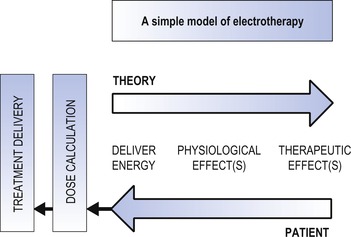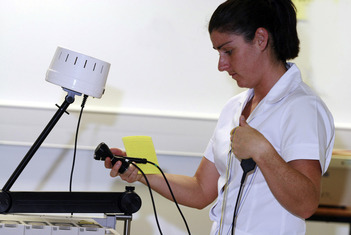5. Electrotherapy
Tim Watson
What is it?
Electrotherapy has been a core component of physiotherapy practice since the very early days of the profession. The whole of electrotherapy goes in and out of fashion and within electrotherapy, different modalities continue to go in and out of fashion on an alarmingly regular basis which doesn’t help when trying to get to grips with it as a subject.
The term “electrotherapy” is not actually very well suited for the context in which it is used. Strictly speaking, electrotherapy relates specifically to the use of electric currents to either treat disease or stimulate nerves and muscles. Within physiotherapy practice, the term “electrotherapy” is taken to include a wide range of treatment modalities (ultrasound, laser, pulsed shortwave, etc.) in addition to the use of electric currents. There is a move towards a change in the general term and electrophysical agents (EPA) is probably the better one to use and is likely to become the norm in the next few years. I will use the term electrotherapy here in its widest context, not just in terms of electric current treatments.
OK, so what is electrotherapy and why do physios use it at all? Well, it is a useful part of the treatment toolkit; it is a means of getting the body to respond to a stimulus in much the same way as it responds to a manual therapy stimulus or an exercise-based stimulus. The only real difference is that in electrotherapy, the stimulus comes from a machine, whether TENS, ultrasound, laser, interferential or myriad others.
It is important to realize that electrotherapy does not belong to physios – there are many other medical and allied professionals who employ electrotherapy in their practice. Historically, we might have been the most avid users within the health service, but it certainly is not something that is exclusive to us.
All electrotherapy works on a pretty straightforward basis, and I will include a very brief version of it here. A fuller explanation can be found in Watson (2008) or on the electrotherapy.org website.
The model is that you apply some energy from a machine, the effect of which is to cause a change in physiologic behavior in the tissues, and we use this change in behavior to bring about a therapeutic benefit. Working in the clinical environment, the best thing is to use the same model but turn it around and work through it in what appears to be a reverse direction. Start with the patient and their problem(s). Decide what you want to achieve and then step back through the model and decide which physiologic response you need in order to get the result you are looking for.
 |
| Fig. 5.2. |
| A simple model of lectrotherapy. |
Having determined the bit of physiology you need to activate, come back through the model again, and decide which modality is most able to help, based on the available evidence. If there is not a modality that does the job you need then electrotherapy is not appropriate for this patient at the moment (though that might change as their clinical status shifts). Having chosen the best modality for the job, the next thing is to determine the dose of energy that will be necessary and then the last step is to “apply” the treatment.
The effects of electrotherapy are both modality and dose dependent. Get them both right and you can expect a positive outcome. Get one or the other wrong and you will not achieve the optimal result. This is no different from manual therapy, exercise therapy, acupuncture, drug therapy or any other intervention in medicine.
Electrotherapy is simply another way to trigger a physiologic response in the tissues. There is a lot of detail that one could add here, but this basic principle is the best one to hang on to in order to understand what we are trying to do. It is rarely best used in isolation – the integration of electrotherapy with other interventions is almost always the optimum way forward. It is not “magic” and is no more clever or important than anything else in the treatment toolkit, but it is a useful additional type of intervention when employed effectively.
I have described the basic mechanism of action using a physiologic intervention model. A lot of people talk about the “placebo” effect of electro-therapy, and some practitioners suggest that all electrotherapy is based on placebo. Well, I would suggest from the evidence that this is clearly not true, but I fully acknowledge that some of the effects of electrotherapy are placebo related (as are some bits of acupuncture, manipulation and exercise – nothing new there). In short, anybody who dismisses electrotherapy on the basis that it is all placebo has not studied the evidence.
There are as many different ways of classifying electrotherapy modalities as there are authors, I reckon. No one classification system is “right” and whichever system is used leaves a gap somewhere or another. By all means have a look at the classification and terminologies proffered in other books, but don’t get too hung up about learning them as they are in a constant state of flux as “new modalities” come along and make the groupings fail one way or another. There is an international group working at the moment on coming up with an electrotherapy classification and terminology system that will be acceptable to all therapists in all countries (dream on!) but until then, the existing groupings provide a useful guide.
Why is it important?
Despite the current trend for electrotherapy to be out of fashion, it is important because it offers the therapist a range of tools to get better treatment out-comes with patients. Therapists who never use electrotherapy are almost certainly denying their patient some useful therapy. Practitioners who use it for everything are probably not making the best treatment choice based on the available evidence.
Stay updated, free articles. Join our Telegram channel

Full access? Get Clinical Tree









